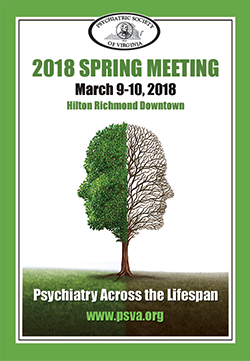Winter 2017 Issue |
|
In the News
A Return for TCA Poisoning? A Review of TCA Overdose for Psychiatrists
By Martekuor Dodoo, EVMS (MD Candidate Class 2018); Stephanie Peglow, DO, MPH
In their most recent annual report, the American Association of Poison Control Centers found that TCAs were involved in just over 10,000 cases in 2015. That year, 2.1% of fatal cases were directly linked to an exposure that included TCAs. Additionally, this class of antidepressants was involved in 2.12% of the 519 fatal exposures where a single substance was the cause of death (Mowry, Spyker, Brooks, Zimmerman, & Schauben, 2016). A study of England and Wales from the United Kingdom’s Office for National Statistics found that TCA led to 5.3 deaths per 100,000 prescriptions in the 1990s (Shah, Uren, Baker, & Majeed, 2001).
However, Virginia providers may soon be seeing an increase in TCA exposures due to new guidelines on chronic pain treatment from the Centers for Disease Control and Prevention (CDC). As the CDC works to decrease opioid prescriptions and thus, opioid addictions, new guidelines recommend TCAs as a pharmacologic treatment option for chronic pain. TCAs are specifically listed as first and second line treatment for neuropathic pain, as well as for fibromyalgia. The guidelines suggest that TCAs will improve the opioid addiction crisis and provide a less expensive treatment option for chronic pain (Dowel, Haegerich, & Chou, 2016).
The clinical symptoms of TCA poisoning that providers can expect to see are explained by the wide-ranging receptor effects of the drug. TCAs cause the blockade of cardiac sodium channels as well as antagonism of peripheral A1 adrenergic, H1 histamine, muscarinic acetylcholine, and CNS GABA A receptors. Patients with overdose may present with seizures and altered mental status including hallucinations, delirium, sedation, and coma. Cardiovascular complications include tachycardia, hypotension, conduction delays such as right bundle blocks, arrhythmia, and acidosis. In severe cases, ECG changes will also appear including QRS prolongation, deep S waves in I and AVL, and tall R waves in AVR. TCAs’ effects on cholinergic receptors means that overdose will produce anticholinergic symptoms such as dilated pupils, dry mouth, urinary retention, flushing, and intestinal ileus.
However, the presentation of symptoms can vary depending on a variety of factors. The average half-life of a TCA is 24 hours, but the range is seven hours (doxepin) to 58 hours (protriptyline). Additionally, there is individual variation in each patient’s absorption kinetics. Absorption of tricyclics depends on the speed of gut motility and metabolic pathway saturation. Due to this, urine and serum TCA measurement have limited use for prognosis. A patient with high serum levels may display little to no clinical symptoms, while a patient with low serum levels may be unstable from TCA toxicity. In many cases, results of TCA levels will often take too long to be beneficial for clinical treatment of the patient.
Initial management of TCA poisoning focuses on stabilizing the patient with the ABCs of trauma: intubation to protect airway, supplemental oxygen for breathing, and fluid resuscitation with vasopressors for hypotension. To combat serum acidosis and cardiac symptoms, intravenous sodium bicarbonate can be given twice. Seizures should be treated with GABA enhancing medications such as benzodiazepines. GI clearing will also be beneficial if the patient is within two hours of ingestion, no obstruction or ileus is suspected, and the airway is stable. If symptoms continue, magnesium may be given for arrhythmia. As TCAs are lipophilic, lipid emulsions can be used for patients who are unstable and continue to have severe symptoms even after first line treatments. Psychiatrists play an important role in preventing and recognizing overdose, their expertise may become increasingly valuable as patients are switched from opiates to TCAs.
Works Cited:
Dowel, D., Haegerich, T. M., & Chou, R. (2016). CDC Guideline for Prescribing Opioids for Chronic Pain — United States, 2016. MMWR. Recommendations and Reports, 65. https://doi.org/10.15585/mmwr.rr6501e1er.
Mowry, J. B., Spyker, D. A., Brooks, D. E., Zimmerman, A., & Schauben, J. L. (2016). 2015 Annual Report of the American Association of Poison Control Centers’ National Poison Data System (NPDS): 33rd Annual Report. Clinical Toxicology, 54(10), 924–1109. https://doi.org/10.1080/15563650.2016.1245421.
Shah, R., Uren, Z., Baker, A., & Majeed, A. (2001). Deaths from antidepressants in England and Wales 1993–1997: analysis of a new national database. Psychological Medicine, 31(7), 1203–1210. https://doi.org/10.1017/S0033291701004548.
YOUR NEWSLETTER IS NOW AVAILABLE ON YOUR SMARTPHONE AND TABLET!
JOIN PSV TODAY!
REGISTER TODAY!
PSV 2018
SPRING MEETING
March 9-10, 2018
Hilton Richmond Downtown
Richmond, Virginia
APA Find a Psychiatrist
Are you accepting new patients?
Opt into APA’s “Find A Psychiatrist” database. To view the functionality or opt-in, CLICK HERE
FYI: A link for this option has been added to the PSV website so the public can find you when they are looking for help.







